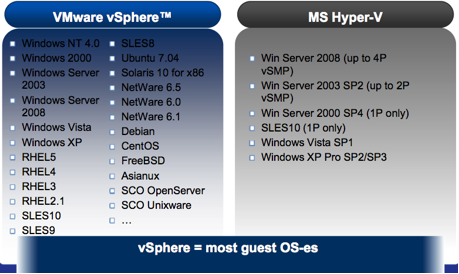vSphere, a feature overview
The software is based on three basic pillars, combined by a single slogan:
"Cut capital and operational costs over 50% for all applications (Efficiency) while automating quality of service (Control) and remaining independent of hardware, operating system, application stack, and service providers (Choice)."
As the efficiency claims will provide quite a challenge for VMware to overcome, let's have a look at the actual changes they have made to their existing software to achieve this goal.

This image depicts the general layout for vSphere: solidifying the Efficiency and Control pillars into three separate parts each: vCompute, vStorage, and vNetwork for Efficiency; Availability, Security, and Scalability for Control.
Until recently, the VMware Infrastructure Efficiency front was largely defined by three of its main features: CPU/Memory Optimization, Dynamic Resource Scheduling, and the VMFS. Each of these was able to provide a boost to performance by taking advantage of the entire virtual infrastructure. Through the combined improvements to vCompute, vStorage and vNetwork, VMware predicts a 30% increased consolidation ratio compared to the last version of VMware Infrastructure. We asked VMware about this, and heard the results were measured by using their very own VMmark, comparing ESX 3.5 and 4.0 on the same hardware platform. We believe the results to be generally realistic, but they should still be taken with a grain of salt.
Furthermore, VMware promises 50% more storage savings, thanks to vStorage Thin Provisioning and up to 20% additional power and cooling savings, thanks to Distributed Power Management that allows the data center to automatically VMotion VMs to as few physical machines as possible, allowing users to power down physical servers that are not needed at the moment.
Besides this, vSphere will offer more powerful virtual machines than before, allowing for:
- 8 vCPUs per VM (up from 4)
- 10 virtual NICs per VM
- up to 255GB RAM per VM
- 3 times more network throughput
- a little over 200,000 IOPS maximum
When it comes out, a single vSphere deployment will be able to manage the following resources:
- 32 physical servers with up to 2048 cores
- 1280 virtual machines
- 32TB of RAM
- 16PB (petabytes - 1000TB) of storage
- 8000 network ports
Keep in mind that it will be possible to cluster up to 10 vCenter Servers (vSphere's main management component).
On the Control side of things, vSphere makes managing this large amount of resources easy through the use of Host Profiles and the vNetwork Distributed Switch, which allows for comprehensive networking between all these virtual machines to be configured just as easily as in a "regular" data center. In fact, the Switch can actually be plugged into by vendors such as Cisco, so it can be configured in exactly the same way as a regular Cisco switch.
As mentioned before in one of our blogs, one-click configurable Fault Tolerance should keep important VMs safe from unexpected hardware failures, and storage-maintenance related downtime should be further minimized by introducing a feature called Storage VMotion. Remember the currently documented limitations of Fault Tolerance, however. It's High Availability, but only on the hardware-level, and will not account for software failures. Also, at this point, Fault Tolerance is limited to VMs with only a single vCPU, so although it's a very interesting feature, it leaves a lot of room for improvement.
Data Recovery is another nice little tidbit, which will essentially plug into your vSphere as a virtual appliance with a single purpose: one-click backup of any virtual machine, answering the first question asked by quite a few companies getting started with virtualization.
Lastly, vShield Zones is a self-learning, self-configuring firewall service, allowing users to set security policies to overall environments, enforcing the rules on an application level, and allowing them to travel along with the VM as it VMotions across the (internal or external) cloud.
For vSphere's last main pillar, VMware likes Choice (as long as they are included in whichever choice you end up making, naturally), and for that reason they proudly hold the claim that they are able to support any kind of server, any kind of storage, any kind of OS, any application, be they on premise or off premise. In the picture below, they compare their own supported OS list to that of Hyper-V.

On top of that, VMware has partnered up with several service providers (as linked before) to properly kick off their external cloud services with a large team of reliable players.










11 Comments
View All Comments
pervisanathema - Wednesday, April 22, 2009 - link
Why the hell would you trash an established and respected brand name in favor of one that sounds like a crappy middleware product from IBM?! Their marketing dept. needs to be terminated.